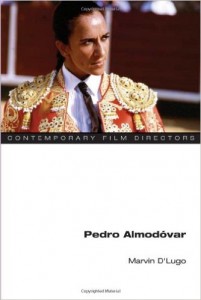 Pedro Almodóvar
Pedro Almodóvar
by Marvin D’Lugo
University of Illinois Press, 176 pages, $19.95
FOR NEARLY A QUARTER of a century, Pedro Almodóvar has been crafting films of increasing beauty and complexity. They are films that explore the political and cultural detritus of the Spanish psyche. Like all great art, they transcend their particularities to offer a vision of the human condition that resonates with all of us.
Almodóvar once remarked, “I am not a gay director who does gay movies for a gay audience.” But he does admit that gay culture informs his films, and anyone familiar with his unforgettable explorations of sex and gender, not to mention his fascination with melodrama, Catholic iconography, and kitsch, could be forgiven for resorting to the facile description of “gay director.” Marvin D’Lugo’s Pedro Almodóvar, part of the University of Illinois’ Contemporary Film Directors series, is a concise but comprehensive analysis of Almodóvar’s work.
The brief biographical sketch provided by D’Lugo points out that the director’s beginnings were modest (he grew up in a farming family), and Almodóvar himself has noted that his upbringing wasn’t necessarily the pedigree one would associate with a film director. Yet his personal biography informs his work in significant ways. D’Lugo delineates, for example, the many Almodóvar films in which the tension between rural and city life is played out in the storyline. The theme of migration from country to city mirrors Almodóvar’s own pivotal migration to Madrid. It’s also helpful to know that Almodóvar trained briefly for the priesthood, which makes it easier to decode the religious themes in his films (these often prompt comparisons with another famous Spanish director, Luis Buñuel).
But history, more than biography, seems to be the primary theme for Almodóvar, and many of his films can be read as reckonings with Spain’s Franco and the post-Franco years. The explorations of gender and sexual liberation in movies like Law of Desire (1987) and Women on the Verge of a Nervous Breakdown (1988), for example, can be read as illustrative fables for Spain’s uneasy transition from tradition to modernity. Almodóvar’s ability to convey his intricately plotted and thematically dense films with such beauty, and his willingness to invoke his cinematic forebears in the service of his unique vision, are powerful testaments to his artistry.
D’Lugo is more than up to the challenge of serving as a guide to Almodóvar’s often difficult work. He is well-versed not only in film theory and Almodóvar scholarship but also in Spanish history, culture, and popular culture. He even explores relatively obscure literary sources such as the fiction of philosopher Miguel de Unamuno. Although D’Lugo carefully identifies the recurring motifs in Almodóvar’s work, his close analysis of the films shows a director who defies easy categorization by being unafraid to challenge himself and to break free of previous boundaries. D’Lugo also helps us to understand this director who’s so eager to play the iconoclast. It was Almodóvar, after all, who prompted the American Academy of Motion Pictures to institute its NC-17 rating in 1989 when his film Tie Me Up! Tie Me Down! was distributed in the United States. In his own country, as well, Almodóvar’s unflinching treatment of his subject matter, particularly with respect to his nation’s troubled past, has earned him death threats.
D’Lugo’s study is structured around separate, detailed analyses of each film, presented in chronological order. He provides brief analytical interludes that frame his discussion in larger terms, but for the most part he allows his close examination of each film to serve as the primary engine of his study. There is no imposition of a theoretical framework, a false structure: D’Lugo allows Almodóvar’s dynamic, uniquely creative achievement to speak for itself, and his inclusion of two important interviews with the director furthers that end. The book also includes a helpful filmography and bibliography. It is, in short, a valuable introduction to, and summation of, the career of one of the world’s most provocative and interesting film directors.





